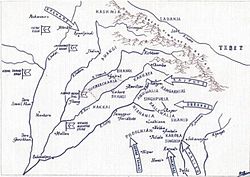History
The misl was formed on 29 March 1748. [6] It was established by Jats. [9] The leaders of this Misl used to carry the blue nishans (the flags) of the Sikh army during the battles; hence their name become Nishanwalia. [10] [11] [6] The misl which was responsible for bearing the Nishan Sahib was the Nishanwalia Misl, named after this role. [12] The Nishanwalia Misl also was responsible for appointing the flag-bearers for the other misls. [12] The role assigned to carry the flag in procession was considered an honourable one. [12]
Dasaundha Singh, son of Chowdhry Sahib Rai of village Mansurwala (near Kot Issa Khan) was the first chief of this Misl. [13] [6] Dasaundha Singh was assisted by his brother, Sangat Singh. [6] Some other prominent figures of the Nishanwalia Misl were Jai Singh of Kairon village, and Kaur Singh and Man Singh of Dhand Kasel village in Amritsar district. [6] These Nishanwalia figures all were earlier baptized into the Khalsa order by Diwan Darbara Singh (d. 1734). [6]
The Nishanwalia Misl had strength of twelve thousand cavalry in 1765. [6] It had captured Ambala, Shahbad-Markanda, Sarai Lashkari Khan, Doraha, Amloh, Zira, Singhanwala and some area around Sahnewal too; Dasaundha Singh died in a battle against Zabita Khan in 1767; he was succeeded by his brother Sangat Singh. [6] [14] Sangat Singh shifted his headquarters from Ambala to Zira, where he died in 1774. [14] [6] Sangat Singh had three sons, namely Kapur Singh, Mehar Singh, and Anup Singh, all of whom were children when their father died. [6] After reaching adulthood, Mehar Singh took on the mantle of leadership of the misl in 1779 but was killed shortly after. [6] Kapur Singh died in-battle. [6] Thus, the sole-surviving son of Sangat Singh, Anup Singh, became the next head of the misl. [6] Anup Singh died without an issue in 1797. [6] In 1807, Maharaja Ranjit Singh occupied the land of the Nishanwalia Misl. [6]
This page is based on this
Wikipedia article Text is available under the
CC BY-SA 4.0 license; additional terms may apply.
Images, videos and audio are available under their respective licenses.
